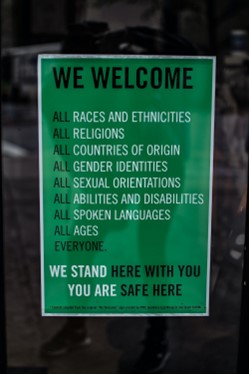Blog: Get DEI buy-in not backlash
Get DEI buy-in not backlash

You want to create positive change. You don’t want your well-intentioned DEI efforts to receive backlash. Inaction and negative responses to DEI initiatives often occur when perceived solutions miss their mark, often focusing on supporting individuals or groups instead of addressing systemic issues that are contributing to inequalities and imbalances.
DEI practitioner, Lily Zheng describes DEI backlash as strong adverse reactions from individuals and groups that undermine or compromise the positive outcomes DEI initiatives try to create. And we aren’t just talking about backlash from people who directly benefit from maintaining the status quo. Backlash can come from anyone, including marginalized community members who feel further isolated or targeted by ineffective DEI efforts.
The consequences of DEI initiative backlash
DEI backlash can result in a regression in equity.
Studies conducted after the #MeToo movement found:
- 19% of men were less willing to hire attractive women
- 21% of men were less willing to hire women for jobs involving close interpersonal interactions
- 27% of men now avoided one-on-one meetings with female colleagues[i]
Mandatory diversity training has been linked to lower levels of representation in leadership positions for Black, Latin, and Asian employees of all genders, and white women, due to resistance from existing leaders.[ii]
Much of the backlash comes from a defensive response posture—we, as individuals, don’t want to be seen as doing wrong (even if we unknowingly have been wrong as often occurs with unconscious bias). To avoid defensive responses, we need to look at changing systems, not individuals. Systems are what support inequities across any industry or institution, so to affect the greatest change, it’s the systems we must overhaul. We need to question what processes and policies are in place that uphold inequities.
Here are two things that can help you avoid DEI backlash.
#1 Turn your DEI problem into an impersonal data set
Nancy Hart, VP of Geo Marketing for NetApp, has a unique approach to problem-solving and team building. It’s an approach that can help you widen the scope of understanding of your corporation’s systemic inequalities and how you can approach fixing them. It starts with collecting qualitative and quantitative data about the employee experience. When collecting the data, go beyond what inequities exist to learn how and why they exist. Then take the data and create a testable hypothesis.
Hart says:
When problems aren’t well defined, we complain about them; we let them bumble along, uninterrupted, and watch them snowball. But by applying basic scientific method to this kind of scope creep, teams can shift their focus to identifying and solving problems.
The key is to create a hypothesis around what drives the problem. This applies to data challenges, it applies to people, and it applies to entire organizations. Creating a hypothesis can be challenging—it requires a deep understanding of how the world works—but once you have it, you can set up a plan to test it. You can collect data and then go back to your hypothesis and see how it held up.
Removing the individual and focusing on data helps to make change more tangible and less personal. When you look at numbers and create a systemic hypothesis, you are far less likely to trigger individual egos. By using data, you can clearly track progress and draw more informed conclusions.
#2 Move beyond representation to inclusion
We want more women and members of marginalized communities to be represented in technology, in corporate leadership, and on boards. However, simply changing the composition of teams and leadership isn’t enough. Touting that a board of directors is 50% female means little if those women’s perspectives aren’t integrated into the decision-making process. Then, they exist purely for optics. That’s not what we want.
We want inclusion. Businesses should too.
Recent research shows that companies whose boards had well-integrated female directors experienced 10% higher stock returns, and their shareholders were 8% less likely to formally dissent to board decisions, than those that diversified without prioritizing real inclusion — even if the board only had one woman.[iii]
Why? Because when directors from underrepresented groups are effectively integrated, boards exhibit a more collaborative decision-making process. Boards where female directors were less integrated tended to use more competitive communication styles, and they would often resort to pre-emptive voting on issues rather than fully discussing differing viewpoints. This often masked underlying disagreements, increased the chances that certain perspectives would be overlooked, and made these boards overconfident in their decisions. In contrast, boards with more-engaged women tended to take the time to reach a common understanding of the problem when disagreement occurred, resulting in more-unified decisions in which everyone understood what was at stake and no one’s voice was disregarded.[iv]
This is just as true of teams as it is of boards. Innovation, collaboration, and communication bloom under the warmth of inclusion.
To build an inclusive team, you first take an intersectional approach to diversity and invest in building a culture of true inclusion, one that empowers and reinforces a systemic framework of inclusion—from recruiting and hiring through to professional development and promotion.
With a The WIT network corporate membership, you’re able to access resources and expertise to help you evaluate the systems you have in place and recognize where change is required. We can help you limit DEI backlash and build out a systemic change framework to create an inclusive corporate culture. Reach out to learn more today: women@thewitnetwork.com.
[i] Forbes, Are Attractive Women Being Shunned by Employers? Tony Robbins Says Yes.https://www.forbes.com/sites/kimelsesser/2018/04/12/are-attractive-women-being-shunned-by-employers-tony-robbins-says-yes/?sh=53fce2f23e85
[ii] HBR, To Avoid DEI Backlash, Focus on Changing Systems — Not People. https://hbr.org/2022/09/to-avoid-dei-backlash-focus-on-changing-systems-not-people
[iii] HBR, Is Your Board Inclusive — or Just Diverse? https://hbr.org/2022/09/is-your-board-inclusive-or-just-diverse
[iv] HBR, Is Your Board Inclusive — or Just Diverse? https://hbr.org/2022/09/is-your-board-inclusive-or-just-diverse

